

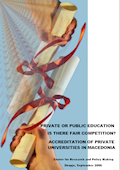
Private or Public Education - Is there Fair Competition?
Приватно или државно образование – постои ли лојална конкуренција?
More...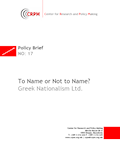
To Name or Not to Name? Greek Nationalism Ltd.
Вето за Македонија победа на грчкиот национализам и како понатаму
More...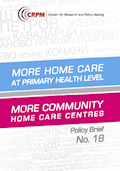
More Care in Primary Health! More Care Centers in the Municipalities!
More Care in Primary Health! More Care Centers in the Municipalities!
More...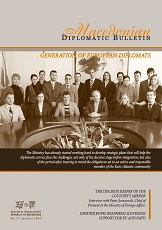
Macedonian Diplomatic Bulletin 2007/04
Macedonian Diplomatic Bulletin 2007/04
Keywords: North Macedonia; NATO; Diplomacy; Euro-Atlantic integration; European Union integration; democracy; Balkans; Kosovo; geopolitics;
More...
Ethnic Communities in Kosovo in 2007 and 2008
Komunitetet Etnike në Kosovë në 2007 dhe 2008
Content: Security Issues, Employment, and Application of Law on the Use of Languages and Anti-discrimination Law in Kosovo; Return of Displaced Persons to Kosovo in 2007 and 2008; Kosovo Institutions Applying the Law on the Use of Languages; Application of Anti-discrimination Law and Law on the Use of Languages in Kosovo Public Companies; Implementation of the Law on the Use of Languages in the Kosovo Education Process.
More...
Security situation in Mitrovicë/Mitrovica during the period December 2008 and January 2009 (Report by HLC — Kosovo)
Situata e sigurisë në Mitrovicë/Mitrovica gjatë periudhës dhjetor 2008 - janar 2009 Raport i FDH — Kosovë)
Following the increase in the number of incidents in North Mitrovica/Mitrovicë which occurred at the end of December 2008, and throughout January 2009, HLC-Kosovo conducted research to systematically monitor the implementation of minority rights in practice, in particular the extent of the implementation of point 31 of article 58 (state responsibilities) of chapter III of the Kosovo constitution and points 3.2 and 3.52 of article 3 of the Law on the Protection and Promotion of the rights of Communities and their Members in Kosovo. The research also sought to identify the level of security in North Mitrovica/Mitrovicë, as well as the causes, consequences and impact that the incidents have had on the overall security situation and everyday life of citizens living in this region. For this purpose, HLC-Kosovo conducted 40 interviews with representatives of local municipal authorities, the judiciary, police, civil society and citizens of all ethnic backgrounds.
More...
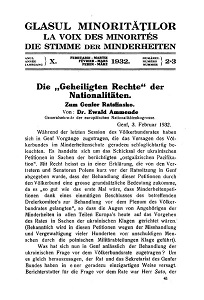
The Voice of the Minorities. 1932-02+03
Glasul Minorităţilor. La Voix des Minorités. Die Stimme der Minderheiten. 1932-02+03
Keywords: Catholic Status in Transilvania; Székler Community; Iorga government; Law on Citizenshíp in Romania; Minority schools in Transilvania;
please find in the » Introduction.pdf « a detailed Table of Content for this issue
More...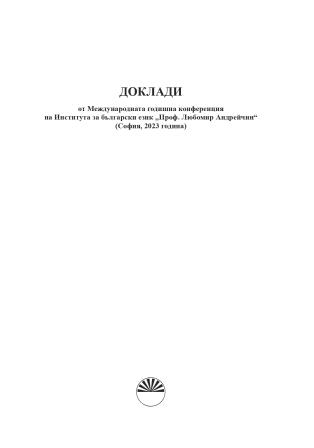
Compound words and phrases meaning ʻcatʼ in the European languages and their dialects
Сложни думи и словосъчетания със значение ʻкоткаʼ в европейските езици и техните диалекти
Keywords: dialectology; linguistic geography; dialect lexicology; word combinations; compound words
The article is the result of the study on the upcoming linguo-geographic description of the names for the domestic cat, Felis domestica, in the European Linguistic Atlas, which was assigned to the Bulgarian Linguistic Commission. The aim of this scientific work is to present the variety of compound words and word combinations with the semantics of ʻcatʼ characteristic of the European languages and their dialects, in order to highlight some interesting trends shared not only by closely related but also by unrelated languages. I present a classification of the analyzed type of names, which is the result of tracing the semantic basis of their origin, as well as the etymology of the words and an analysis of their formal paradigms. In addition, parallels are drawn between the names for a cat and other objects from reality
More...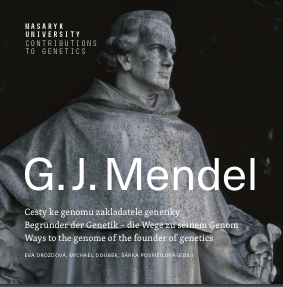
Invitation to the exploratory research ways
Pozvání na výzkumné cesty - Die Wege der Forschung betreten – eine Einladung
Keywords: science; Gregor Johann Mendel; genetics;
There are not many scientists who have managed to lay the foundations for an entire scientific field. And there are certainly not many who have achieved such a feat in this country. Therefore great respect is due Gregor Johann Mendel, considered the founder of genetics, who worked for most of his life in the Augustinian monastery at Old Brno and, on the basis of his experimental work, formulated the laws of heredity that are now called by his name throughout the world. However, Mendel was a much more interdisciplinary scientist, involved in many different fields. In addition to conducting thousands of challenging experiments investigating the inheritance of individual traits in peas, Mendel was also interested in meteorology, beekeeping and breeding. In addition, he also served as a priest, abbot of the St. Thomas Monastery, and even as a bank director. We can hardly imagine such a wide range of activities among contemporary scientists.
More...
Gregor Johann Mendel – A man of many talents, professions and vocations
Gregor Johann Mendel – muž řady talentů, profesí i poslání Erster Weg - Gregor Johann Mendel – ein Mann vieler Talente, Berufe und Berufungen
Keywords: Gregor Johann Mendel; genetics; science; talent; profession; vocation;
Johann was born on 20 July 1822 in Hynčice, Silesia, into the family of German-speaking small farmers Anton and Rosina Mendel. He had an older and a younger sister (two of this other sisters died early in childhood). • From an early age, the boy was very curious. He found many stimuli in his father’s orchard and apiary. Already at elementary school, his teacher noticed his unusual interest in learning. From this time, his life took a course different from that which one might expect from his family background...
More...
Examining the personal possessions of G. J. Mendel: The quest for DNA
Výzkum osobních předmětů G. J. Mendela – zdroj hledání DNA - G. J. Mendels persönliche Utensilien – DNA-Quelle dringend gesucht
Keywords: Gregor Johann Mendel; genetics; genome;
From the very first stages of planning the project to study the genome of Gregor Johann Mendel, it was clear that if Mendel’s remains were found in the tomb, it would not be possible to unequivocally identify them without a reference genetic material. The Augustinian tomb at the Brno Central Cemetery, where Gregor Johann Mendel is buried, has been used for more than 150 years, and the coffins are placed there more or less anonymously, and not in any order.
More...
Archaeological research on the Augustinian tomb
Archeologický výzkum augustiniánské hrobky - Archäologen in der Augustinergruft
Keywords: Gregor Johann Mendel; tomb; Augustinian tomb; archaeology;
The archaeological research during the exhumation of the remains of Gregor Johann Mendel was carried out by a team of archaeologists from Archaia Brno in cooperation with the Department of Archaeology and Museology of the Faculty of Arts of Masaryk University. The two institutions had cooperated on several previous projects. The exhumation of human skeletal remains has become an almost daily practice for Archaia’s employees since the establishment of the company’s Brno office. Over the quarter of a century of its existence, it has recovered the remains of thousands of buried individuals on many occasions, mostly as part of rescue archaeological excavations in Brno carried out in connection with various construction activities that disrupted prehistoric and early medieval burial sites or high medieval or modern cemeteries. Specific burial sites such as ossuaries, church crypts and mass graves have also been investigated in recent decades (Holub et al., 2006; Merta & Sedláčková, 2013; Zůbek, 2013, 2018; Živný, 2010). However, the research in retrieving the remains of Gregor Johann Mendel was exceptional in two ways. Unlike these other activities, this project took place on the grounds of a functioning cemetery and its subject was the remains of a known person, compared to the prior exhumations from the graves of multitudes of nameless deceased.
More...
Exhumation of the remains of G. J. Mendel
Exhumace ostatků G. J. Mendela - Die Exhumierung
Keywords: Gregor Johann Mendel; genetics; exhumation;
Immediately after the archaeologists lifted the coffin with the remains of Gregor Johann Mendel from the grave in the tomb of the Augustinian Order at the Brno Central Cemetery, the coffin was transported to the local morgue. It was here where all the tasks related to the field anthropological research were carried out: the taking of samples for genetic analysis, the removal of the body from the coffin, and the removal and safe storage of all the artefacts which were present in the coffin along with the bodily remains.
More...
Examination of the skeletal remains of G. J. Mendel
Výzkum kosterních pozůstatků G. J. Mendela - Das Skelett
Keywords: Gregor Johann Mendel; exhumation; examination; skeletal remains;
After being removed from the coffin, the skeletal remains of Gregor Johann Mendel were transported for further anthropological analysis to the Laboratory of Biological and Molecular Anthropology of the Section of Genetics and Molecular Biology at the Department of Experimental Biology of the Faculty of Science, Masaryk University. After a brief acclimatisation in the skeletal material depository, the state of the bone tissue was evaluated, and the anthropological analysis commenced. First, the individual bones were cleaned. Because they were in good condition, no complicated reconstruction was necessary. Most of the bones, except for the pelvic bones and the tibiae, were intact. At this stage, the skeletal remains were ready for anthropological study. • The bones were well preserved. The best preserved were the skull and the upper part of the postcranial skeleton.
More...
Identification of the bodily remains of G. J. Mendel
Identifizierung der leiblichen Überreste von G. J. Mendel
Keywords: Gregor Johann Mendel; bodily remains; archaeology;
The identification of the remains of Gregor Johann Mendel was a crucial step in the research on his skeletal remains. No details were known about the burial of his remains in the tomb. The only established fact was that his coffin with his remains was buried in this location. In order to be sure that we were really examining the remains of Gregor Johann Mendel, his remains had to be identified by all available means. Archaeologically, based on the order and the position of the coffin in the tomb. Anthropologically, by comparing the biological parameters of the remains found in the coffin that was assumed to be his with known facts from his life. Most important, however, was genetic identification, which can identify an individual with a probability approaching 100%.
More...The search is temporarily unavailable.
We apologize in advance for the inconvenience and thank you for your kind understanding.
